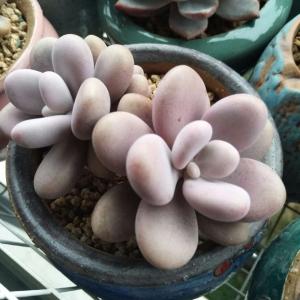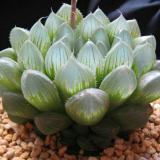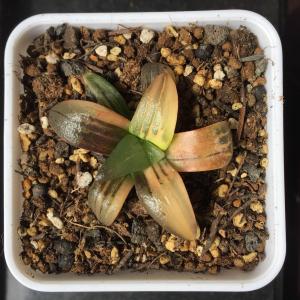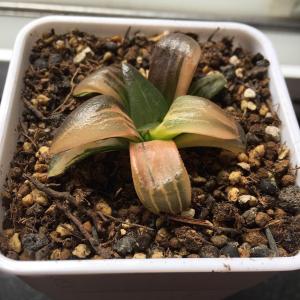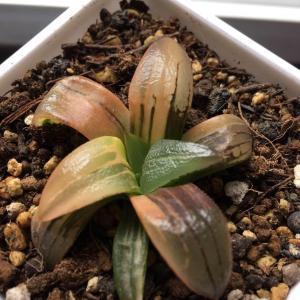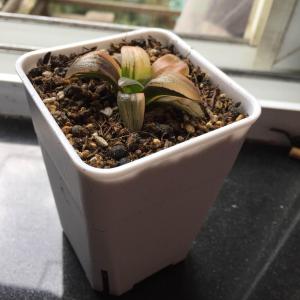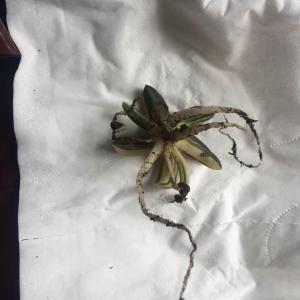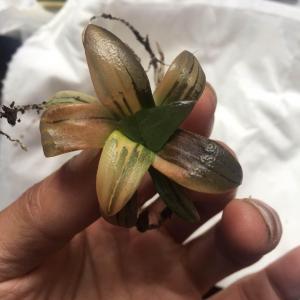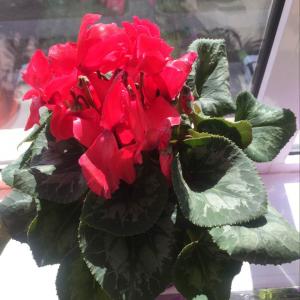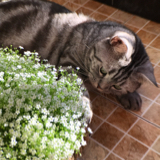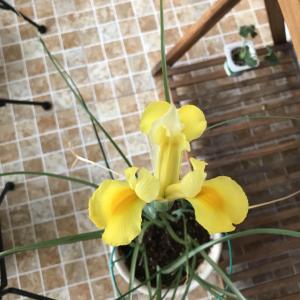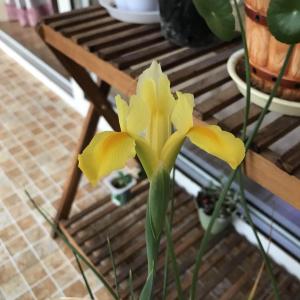文章
Miss Chen
2018年03月08日

Description: This herbaceous plant is a summer annual about 2-6' tall. It branches regularly from the central stem, while the side stems branch very little. These stems are somewhat pubescent and green to reddish green. The opposite leaves are up to 12" and 4" across, becoming smaller as they ascend the stems. The lower leaves are pinnately lobed, cleft, and coarsely toothed, while the upper leaves are lanceolate-oblong and smooth along the margins. The petioles of the leaves become progressively shorter toward the apex of the plant; the upper leaves are often sessile. Both lower and upper leaves are hairless, or nearly so.
The upper stems terminate in spike-like racemes of yellow flowers. These racemes vary ½–3' in length, depending on the size of the plant. Each flower is about ½" long, consisting of a yellow tubular corolla with 5 spreading lobes and a green calyx with 5 blunt teeth. The tubular corolla is rather short and broad; its throat is partially obstructed by an abundance of fine yellow hairs. The two upper lobes of the corolla fold backward, while the 3 lower lobes function as a landing pad for visiting insects. The blooming period is mid-summer to early fall and lasts about 1½ months; only a few flowers are in bloom at the same time. Each flower is replaced by a seed capsule is globoid-ovoid; it eventually turns brown and contains several seeds. The root system consists of a taproot and secondary feeder roots. The feeder roots can attach themselves to the roots of oak trees; they suck moisture and possibly some nutrients from the host tree. Thus, Mullein Foxglove is partially parasitic. Reproduction is by seed.
Cultivation: The preference is partial sun, mesic to dry conditions, and a loam, clay-loam, or rocky soil. This plant benefits from the proximity of oak trees. Its size is highly variable, depending on growing conditions.

Range & Habitat: The native Mullein Foxglove occurs occasionally throughout most of Illinois; it is least common in the NW and south-central areas of the state (see Distribution Map). Habitats include open rocky woodlands, oak savannas, paths through woodlands, thinly wooded bluffs, woodland borders, thickets, and rocky slopes along rivers. This species tolerates low to moderate levels of disturbance.
Faunal Associations: The most important pollinators of the flowers are bumblebees, which suck nectar and collect pollen. Other long-tongued bees also visit the flowers, including honeybees and Miner bees. Occasionally, butterflies and skippers suck nectar from the flowers, but they are ineffective pollinators. The caterpillars of the moth Rhodoecia aurantiago (Orange Sallow) bore into the seed capsules and feed on the seeds. It possible that the foliage is eaten by the caterpillars of the butterflies Junonia coenia (Buckeye) and Euphydryas phaeton ozarkae (Baltimore). The latter variety of the Baltimore is confined to southern Illinois. Both of these butterfly species are known to feed on the foliage of Aureolaria spp. (False Foxgloves), which are closely related to Mullein Foxglove.

Photographic Location: Along a path at Busey Woods in Urbana, Illinois.
Comments: This annual plant can achieve an impressive size. It closely resembles several Aureolaria spp. (False Foxgloves), which are also parasitic on the roots of oaks. The flowers of Mullein Foxglove are a little shorter than the flowers of the latter species (which can exceed ¾" in length), and the throat of its flowers are partially obstructed by an abundance of fine hairs. The flowers of the False Foxgloves are quite open at the throat because they lack these hairs. Another scientific name for Mullein Foxglove is Seymeria macrophylla.
The upper stems terminate in spike-like racemes of yellow flowers. These racemes vary ½–3' in length, depending on the size of the plant. Each flower is about ½" long, consisting of a yellow tubular corolla with 5 spreading lobes and a green calyx with 5 blunt teeth. The tubular corolla is rather short and broad; its throat is partially obstructed by an abundance of fine yellow hairs. The two upper lobes of the corolla fold backward, while the 3 lower lobes function as a landing pad for visiting insects. The blooming period is mid-summer to early fall and lasts about 1½ months; only a few flowers are in bloom at the same time. Each flower is replaced by a seed capsule is globoid-ovoid; it eventually turns brown and contains several seeds. The root system consists of a taproot and secondary feeder roots. The feeder roots can attach themselves to the roots of oak trees; they suck moisture and possibly some nutrients from the host tree. Thus, Mullein Foxglove is partially parasitic. Reproduction is by seed.
Cultivation: The preference is partial sun, mesic to dry conditions, and a loam, clay-loam, or rocky soil. This plant benefits from the proximity of oak trees. Its size is highly variable, depending on growing conditions.

Range & Habitat: The native Mullein Foxglove occurs occasionally throughout most of Illinois; it is least common in the NW and south-central areas of the state (see Distribution Map). Habitats include open rocky woodlands, oak savannas, paths through woodlands, thinly wooded bluffs, woodland borders, thickets, and rocky slopes along rivers. This species tolerates low to moderate levels of disturbance.
Faunal Associations: The most important pollinators of the flowers are bumblebees, which suck nectar and collect pollen. Other long-tongued bees also visit the flowers, including honeybees and Miner bees. Occasionally, butterflies and skippers suck nectar from the flowers, but they are ineffective pollinators. The caterpillars of the moth Rhodoecia aurantiago (Orange Sallow) bore into the seed capsules and feed on the seeds. It possible that the foliage is eaten by the caterpillars of the butterflies Junonia coenia (Buckeye) and Euphydryas phaeton ozarkae (Baltimore). The latter variety of the Baltimore is confined to southern Illinois. Both of these butterfly species are known to feed on the foliage of Aureolaria spp. (False Foxgloves), which are closely related to Mullein Foxglove.

Photographic Location: Along a path at Busey Woods in Urbana, Illinois.
Comments: This annual plant can achieve an impressive size. It closely resembles several Aureolaria spp. (False Foxgloves), which are also parasitic on the roots of oaks. The flowers of Mullein Foxglove are a little shorter than the flowers of the latter species (which can exceed ¾" in length), and the throat of its flowers are partially obstructed by an abundance of fine hairs. The flowers of the False Foxgloves are quite open at the throat because they lack these hairs. Another scientific name for Mullein Foxglove is Seymeria macrophylla.
0
0
心扉的猫咪
2018年03月06日

2018.3.6
1.蓝雪苗长势不错,欢了大盆
2.文竹移入了单间,爆出新芽
3.发财树之前都掉光了叶子,今日开始抽新枝
4.三色堇长出新花苞
5.瓜叶菊新买的,看看花而已
6.捡回家的紫罗兰,随便种种
7.不知是小丽花还是大丽花,也是刚捡到的
8.前年的红色重瓣长寿,花苞出了一个多月了,还没开
9.仙客来好像长了虫子,用了药试试看
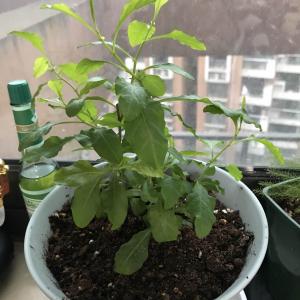
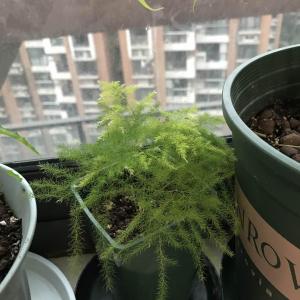
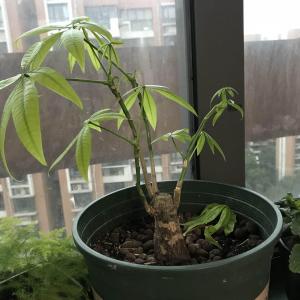
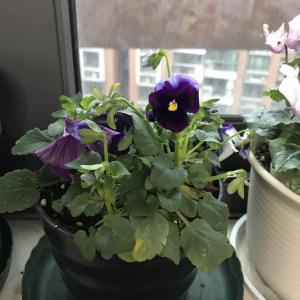
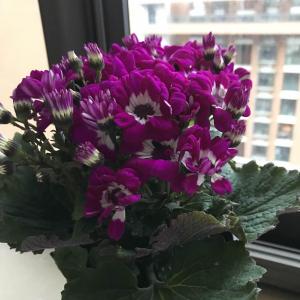
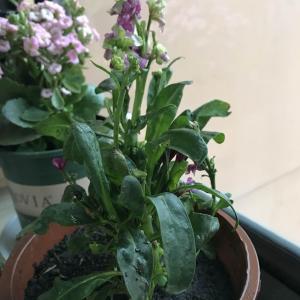
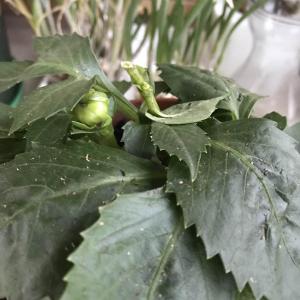
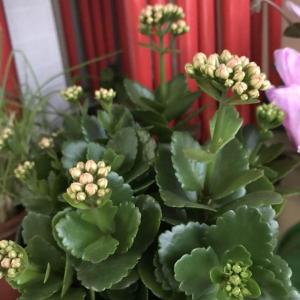

1.蓝雪苗长势不错,欢了大盆
2.文竹移入了单间,爆出新芽
3.发财树之前都掉光了叶子,今日开始抽新枝
4.三色堇长出新花苞
5.瓜叶菊新买的,看看花而已
6.捡回家的紫罗兰,随便种种
7.不知是小丽花还是大丽花,也是刚捡到的
8.前年的红色重瓣长寿,花苞出了一个多月了,还没开
9.仙客来好像长了虫子,用了药试试看









0
0
文章
Miss Chen
2018年03月04日

Description: This perennial plant is about 1¾-2¾' tall and unbranched. The central stem is light green, round in cross-section (terete), and glabrous to finely pubescent. The opposite leaves are up to 6" long and 3" across. They are ovate-oblong or broadly lanceolate, with smooth margins that may undulate up and down. The leaves often curl upward from the pinkish central vein. The upper surface of the foliage is mostly glabrous and yellowish green to dark green (depending on light conditions), while the lower surface is light green and softly pubescent (at least along the major veins). Leaf venation is pinnate. The central stem terminates with 1-6 umbels of flowers; there may be a few axillary umbels from some of the upper leaves as well. Each rounded umbel is about 2-3" across. These flowers have the typical structure for milkweeds; they are pale purple to deep purple, sometimes with greenish or rosy tints. However, the central reproductive column and the bases of the deflexed petals are more pale than the rest of the flower.
Flowering Plant
The hoods are much taller than the horns; the latter curve inward toward the reproductive column and appear spike-like (but are slightly thicker toward the base). The blooming period occurs from late spring to mid-summer, and lasts about one month. The flowers have a pleasant fragrance. If cross-pollination occurs, the flowers are replaced by seedpods (follicles) that are held erect. These seedpods are up to 6" long and 1" across; they are narrowly lanceoloid in shape. They have a smooth surface and are finely short-pubescent or canescent. The seeds have large tufts of white hair; they are distributed by the wind. The root system consists of a fleshy taproot and rhizomes; small colonies of plants are sometimes produced from the rhizomes.
Cultivation: The preference is partial sun and mesic conditions; this plant also tolerates light shade and full sun, as well as considerable variations in the moisture regime. Immature plants are inclined to wilt during a drought, and should be watered. The soil can consist of moisture-retaining loam or clay-loam. The plants make rapid growth during the late spring until they flower and form seedpods, then they gradually degenerate. It takes 3 years or more for a small transplant or seedling to reach flowering size. The leaves have tendency to turn yellow and curl in response to dry sunny conditions, or when they become old.
Range & Habitat: The native Purple Milkweed is an occasional plant that is widely distributed in Illinois (see Distribution Map). However, it is uncommon or absent in some areas of NW, central, and east-central Illinois. Habitats include lower slopes of hill prairies, meadows in wooded areas, thickets and woodland borders, bluffs and open woodlands, oak savannas, glades, and roadsides. This plant usually occurs along prairie edges near wooded areas, rather than in open prairie. It is usually found in higher quality habitats.

Faunal Associations: The nectar of the flowers attracts long-tongued bees, butterflies, and skippers. To a lesser extent, green metallic bees and other Halictid bees may visit the flowers, but they are less effective at pollination. Another unusual visitor of the flowers is the Ruby-Throated Hummingbird. Among the butterflies, such visitors as the Pipevine Swallowtail, Giant Swallowtail, American Painted Lady, Red Admiral, Clouded Sulfur, Eastern Tailed-Blue, Regal Fritillary, Great Spangled Fritillary, and many others have been reported. A group of oligophagous insects feed on milkweeds. They include caterpillars of the butterfly Danaus plexippes (Monarch); caterpillars of the moths Cycnia inopinatus (Unexpected Cycnia) and Cycnia tenera (Delicate Cycnia); the aphids Aphis asclepiadis, Aphis nerii, and Myzocallis asclepiadis; Lygaeus kalmii (Small Milkweed Bug) and Oncopeltus fasciatus (Large Milkweed Bug); and Tetraopes tetrophthalmus (Red Milkweed Beetle). Mammalian herbivores rarely consume Purple Milkweed and other milkweeds because of the bitter-tasting, toxic foliage, which contains cardiac glycosides.

Photographic Location: The photographs were taken at the webmaster's wildflower garden in Urbana, Illinois, and at the Coneflower Hill Prairie near Lake Shelbyville in east-central Illinois.
Comments: The flowers of Purple Milkweed are quite attractive. This species is less aggressive than Asclepias syriaca (Common Milkweed), which it resembles somewhat in appearance. However, the flowers of Purple Milkweed are usually a deeper color of purple and more likely to occur in terminal umbels at the apex of the central stem, rather than as axillary umbels between the upper leaves. The seedpods of Purple Milkweed are smooth, while the seedpods of Common Milkweed have soft prickles. Purple Milkweed also resembles Asclepias rubra (Red Milkweed), but the horns on the flowers of the latter species are straight and about as tall as the hoods, while the horns of Purple Milkweed are shorter than the hoods and curve inward toward the reproductive column of the flowers.
Flowering Plant
The hoods are much taller than the horns; the latter curve inward toward the reproductive column and appear spike-like (but are slightly thicker toward the base). The blooming period occurs from late spring to mid-summer, and lasts about one month. The flowers have a pleasant fragrance. If cross-pollination occurs, the flowers are replaced by seedpods (follicles) that are held erect. These seedpods are up to 6" long and 1" across; they are narrowly lanceoloid in shape. They have a smooth surface and are finely short-pubescent or canescent. The seeds have large tufts of white hair; they are distributed by the wind. The root system consists of a fleshy taproot and rhizomes; small colonies of plants are sometimes produced from the rhizomes.
Cultivation: The preference is partial sun and mesic conditions; this plant also tolerates light shade and full sun, as well as considerable variations in the moisture regime. Immature plants are inclined to wilt during a drought, and should be watered. The soil can consist of moisture-retaining loam or clay-loam. The plants make rapid growth during the late spring until they flower and form seedpods, then they gradually degenerate. It takes 3 years or more for a small transplant or seedling to reach flowering size. The leaves have tendency to turn yellow and curl in response to dry sunny conditions, or when they become old.
Range & Habitat: The native Purple Milkweed is an occasional plant that is widely distributed in Illinois (see Distribution Map). However, it is uncommon or absent in some areas of NW, central, and east-central Illinois. Habitats include lower slopes of hill prairies, meadows in wooded areas, thickets and woodland borders, bluffs and open woodlands, oak savannas, glades, and roadsides. This plant usually occurs along prairie edges near wooded areas, rather than in open prairie. It is usually found in higher quality habitats.

Faunal Associations: The nectar of the flowers attracts long-tongued bees, butterflies, and skippers. To a lesser extent, green metallic bees and other Halictid bees may visit the flowers, but they are less effective at pollination. Another unusual visitor of the flowers is the Ruby-Throated Hummingbird. Among the butterflies, such visitors as the Pipevine Swallowtail, Giant Swallowtail, American Painted Lady, Red Admiral, Clouded Sulfur, Eastern Tailed-Blue, Regal Fritillary, Great Spangled Fritillary, and many others have been reported. A group of oligophagous insects feed on milkweeds. They include caterpillars of the butterfly Danaus plexippes (Monarch); caterpillars of the moths Cycnia inopinatus (Unexpected Cycnia) and Cycnia tenera (Delicate Cycnia); the aphids Aphis asclepiadis, Aphis nerii, and Myzocallis asclepiadis; Lygaeus kalmii (Small Milkweed Bug) and Oncopeltus fasciatus (Large Milkweed Bug); and Tetraopes tetrophthalmus (Red Milkweed Beetle). Mammalian herbivores rarely consume Purple Milkweed and other milkweeds because of the bitter-tasting, toxic foliage, which contains cardiac glycosides.

Photographic Location: The photographs were taken at the webmaster's wildflower garden in Urbana, Illinois, and at the Coneflower Hill Prairie near Lake Shelbyville in east-central Illinois.
Comments: The flowers of Purple Milkweed are quite attractive. This species is less aggressive than Asclepias syriaca (Common Milkweed), which it resembles somewhat in appearance. However, the flowers of Purple Milkweed are usually a deeper color of purple and more likely to occur in terminal umbels at the apex of the central stem, rather than as axillary umbels between the upper leaves. The seedpods of Purple Milkweed are smooth, while the seedpods of Common Milkweed have soft prickles. Purple Milkweed also resembles Asclepias rubra (Red Milkweed), but the horns on the flowers of the latter species are straight and about as tall as the hoods, while the horns of Purple Milkweed are shorter than the hoods and curve inward toward the reproductive column of the flowers.
0
0
文章
Miss Chen
2018年03月04日

Description: This perennial wildflower forms a rosette of basal leaves spanning up to 1' across. The basal leaves are up to 8" long and 6" across; they are oval-cordate or oval and their margins are undulate-angular to shallowly cleft. The petioles of the basal leaves are up to 6" long, light green, glabrous, and rather stout. The upper surfaces of the leaves are medium to dark green and glabrous, while their lower surfaces are pale greenish white to bright white. During the spring, an unbranched flowering stalk with alternate leaves develops; it becomes 3-9' tall. The central stalk is pale green to pale purple, terete, glabrous, and glaucous; fine longitudinal veins are often visible along this stalk. The alternate leaves are up to 8" long and 8" across, becoming gradually smaller as they ascend the central stalk. The leaves are mostly deltate-cordate, deltate-orbicular, or deltate-ovate; their margins are shallowly to moderately cleft with pointed lobes and to some extent undulate-angular. The upper and lower surfaces of the alternate leaves have the same characteristics as the basal leaves, and both types of leaves have palmate veins. The petioles along the central stalk are about as long as their leaves; they are light green and glabrous.
The central stalk terminates in a flat-topped panicle (or compound corymb) of flowerheads. The flowerheads are usually arranged in small clusters of 4-15 flowerheads. The branches of the panicle are light green and glabrous. Individual flowerheads are about 1/8" (3 mm.) across and 1/3" (8 mm.) long, consisting of an involucre (base of the flowerhead) with 5 bracts in a single series and 5 disk florets. In addition, there may be 2-3 tiny bracteoles near the base of the flowerhead. Each disk floret has a tubular corolla with 5 narrow lobes and an exerted bipartite style; the corolla is cream-colored, greenish white, or pale purplish white. The bracts of the involucre are linear-lanceolate, light green (sometimes tinted purple), and glabrous. The blooming period occurs from mid-summer to early fall and lasts about 1 month. Each fertile disk floret produces an oblongoid achene with a tuft of white hair. The achenes are distributed by the wind.
Cultivation: The preference is full sun to light shade, moist to dry-mesic conditions, and loamy, rocky, or sandy soil.
Range & Habitat: The native Pale Indian Plantain is occasional throughout most of Illinois, except in the NW corner of the state, where it is largely absent (see Distribution Map). Habitats include upland woodlands, rocky woodlands, woodland borders, wooded slopes and slopes of ravines, woodland openings, typical savannas and sandy savannas, typical thickets and sandy thickets, partially shaded areas of sand dunes near Lake Michigan, banks of streams, and prairies. Occasional wildfires and removal of woody vegetation is probably beneficial in maintaining the habitat of this wildflower.

Faunal Associations: In order to set fertile seed, the florets require cross-pollination by insects. Such insect visitors are relatively few; they consist primarily of wasps, flies, and small bees, which are attracted to either the nectar or pollen. The larvae of a lizard beetle, Languria bicolor, bore through the stems of Pale Indian Plantain (Vestal, 1913), while the larvae of a moth, Phyllocnistis insignis, are serpentine leaf-miners (Microleps website, 2010).
Photographic Location: A prairie in Fayette County, Illinois. The photographs were taken by Keith and Patty Horn (Copyright © 2009).
Comments: Pale Indian Plantain can become quite tall. It has interesting foliage that looks like it was made of plastic. Unlike other Arnoglossum spp. (Indian Plantains) in Illinois, Pale Indian Plantain has leaves with whitened undersides (varying from pale greenish white to bright white). The common name, 'Indian Plantain,' refers to another species in this genus that has plantain-shaped leaves. A scientific synonym of Pale Indian Plantain is Cacalia atriplicifolia.
The central stalk terminates in a flat-topped panicle (or compound corymb) of flowerheads. The flowerheads are usually arranged in small clusters of 4-15 flowerheads. The branches of the panicle are light green and glabrous. Individual flowerheads are about 1/8" (3 mm.) across and 1/3" (8 mm.) long, consisting of an involucre (base of the flowerhead) with 5 bracts in a single series and 5 disk florets. In addition, there may be 2-3 tiny bracteoles near the base of the flowerhead. Each disk floret has a tubular corolla with 5 narrow lobes and an exerted bipartite style; the corolla is cream-colored, greenish white, or pale purplish white. The bracts of the involucre are linear-lanceolate, light green (sometimes tinted purple), and glabrous. The blooming period occurs from mid-summer to early fall and lasts about 1 month. Each fertile disk floret produces an oblongoid achene with a tuft of white hair. The achenes are distributed by the wind.
Cultivation: The preference is full sun to light shade, moist to dry-mesic conditions, and loamy, rocky, or sandy soil.
Range & Habitat: The native Pale Indian Plantain is occasional throughout most of Illinois, except in the NW corner of the state, where it is largely absent (see Distribution Map). Habitats include upland woodlands, rocky woodlands, woodland borders, wooded slopes and slopes of ravines, woodland openings, typical savannas and sandy savannas, typical thickets and sandy thickets, partially shaded areas of sand dunes near Lake Michigan, banks of streams, and prairies. Occasional wildfires and removal of woody vegetation is probably beneficial in maintaining the habitat of this wildflower.

Faunal Associations: In order to set fertile seed, the florets require cross-pollination by insects. Such insect visitors are relatively few; they consist primarily of wasps, flies, and small bees, which are attracted to either the nectar or pollen. The larvae of a lizard beetle, Languria bicolor, bore through the stems of Pale Indian Plantain (Vestal, 1913), while the larvae of a moth, Phyllocnistis insignis, are serpentine leaf-miners (Microleps website, 2010).
Photographic Location: A prairie in Fayette County, Illinois. The photographs were taken by Keith and Patty Horn (Copyright © 2009).
Comments: Pale Indian Plantain can become quite tall. It has interesting foliage that looks like it was made of plastic. Unlike other Arnoglossum spp. (Indian Plantains) in Illinois, Pale Indian Plantain has leaves with whitened undersides (varying from pale greenish white to bright white). The common name, 'Indian Plantain,' refers to another species in this genus that has plantain-shaped leaves. A scientific synonym of Pale Indian Plantain is Cacalia atriplicifolia.
0
0
文章
Miss Chen
2018年03月02日

Description: This perennial plant is up to 6" tall (rarely taller), consisting of a basal rosette of leaves and an erect stem bearing the inflorescence. Species in this genus are dioecious, with individual plants bearing either staminate (male) or pistallate (female) flowers. The basal leaves are up to 3½" long and 2" across; they are obovate in shape with long petioles and their margins are smooth. Mature basal leaves have 3-5 conspicuous veins. The upper surfaces of these leaves are light to medium green and glabrous to appressed-hairy, while their lower surfaces are whitish green and densely appressed-hairy. Sometimes basal leaves become more glabrous with age. During the spring, a central stem develops from the basal leaves. This central stem is densely covered with appressed white hairs; along its length, there are a few alternate leaves. These leaves clasp the stem and they are erect or ascending. Individual alternate leaves are up to 1½" long, narrowly lanceolate or elliptic in shape, and smooth to undulate; they tend to be more hairy than the basal leaves. At the apex of the central stem is a small cluster of about 3-6 staminate or pistillate flowerheads.
The flowerheads are about ¼–½" long and a little less across; they have phyllaries (floral bracts) at their bases that are light green and hairy, otherwise they consist of white disk florets. The staminate florets have brownish tubular anthers, while the pistillate florets are fluffy white from an abundance of styles. The blooming period occurs during mid- to late spring, lasting about 2-3 weeks. There is no noticeable floral scent. While the flowers are capable of cross-pollination by means of either wind or insects, they are also capable of self-pollination. Afterwards, the florets are replaced by achenes that resemble small brown nutlets with white resinous dots, to which small tufts of white hair are attached. They are distributed by the wind. The flower-bearing part of the plant dies down during the summer, but the rosette of basal leaves persists. Occasionally, this plant forms stolons that can take root a short distance from the mother plant, forming clonal offsets. There is a strong tendency to form colonies, sometimes consisting of all staminate or pistillate plants.

Cultivation: The preference is full sun to light shade and average to dry conditions. This plant often flourishes in poor soil that contains sand, rocky material, or clay. Young growth during the spring is rarely bothered by disease, although the semi-evergreen basal leaves often become discolored and withered with age.
Range & Habitat: Plantain-Leaved Pussytoes has been found in most of the counties of Illinois (see Distribution Map), where it is both native and common. Habitats include hill prairies, openings in upland forests, wooded slopes, bluffs, limestone glades, areas along woodland paths, disturbed open woodlands, thickets, pastures, and abandoned fields. Both sandy and non-sandy areas can provide suitable habitat. This little plant favors areas with reduced ground competition that are partially sunny. Occasional wildfires are probably beneficial as this reduces competition from woody vines and shrubs.

Faunal Associations: The flowers are visited primarily by small bees and flies. Among the bees, this includes Andrenid bees, Halictid bees, and cuckoo bees (Nomada spp.), while fly visitors consist primarily of Syrphid flies and, to a lesser extent, flesh flies, blow flies, Muscid flies, and others. Insects that feed on Plantain-leaved Pussytoes and other Antennaria spp. (Pussytoes) include larvae of the fly Chromatomyia syngenesiae (Chrysanthemum Leafminer), gall-forming larvae of the flies Aspondylia antennariae (Everlasting Bud Midge) and Rhopalomyia antennariae (Pussytoes Bud Midge), larvae of Tebenna gnaphaliella (Everlasting Tebenna Moth), caterpillars of the butterfly Vanessa virginiensis (American Painted Lady), and the aphid Pleotrichophorus antennarius. To a limited extent, the Bobwhite Quail eats the seeds, while the White-Tailed Deer and Cottontail Rabbit browse on the foliage.

Photographic Location: The photograph of the pistillate flowerheads was taken along a woodland path at Busey Woods in Urbana, Illinois, while the remaining photographs were taken at a hilly woodland in east-central Illinois.
Comments: Plantain-leaved Pussytoes can be readily distinguished from Antennaria neglecta (Field Pussytoes) by its basal leaves. The latter species has basal leaves that are single-veined and more narrow. Field Pussytoes is also more typical of open habitats, rather than woodland areas. Because Plantain-leaved Pussytoes is a rather variable species, it is often divided into different varieties or subspecies; some authorities even divide it into different species (Mohlenbrock, 2002). These distinctions take into consideration the length of phyllaries (floral bracts) in pistillate (female) plants, and the hairiness or shape of the basal leaves. No attempt has been made to make such fine distinctions here. Some authorities state that these plants are wind-pollinated, while others emphasize the role of insects in cross-pollination.
The flowerheads are about ¼–½" long and a little less across; they have phyllaries (floral bracts) at their bases that are light green and hairy, otherwise they consist of white disk florets. The staminate florets have brownish tubular anthers, while the pistillate florets are fluffy white from an abundance of styles. The blooming period occurs during mid- to late spring, lasting about 2-3 weeks. There is no noticeable floral scent. While the flowers are capable of cross-pollination by means of either wind or insects, they are also capable of self-pollination. Afterwards, the florets are replaced by achenes that resemble small brown nutlets with white resinous dots, to which small tufts of white hair are attached. They are distributed by the wind. The flower-bearing part of the plant dies down during the summer, but the rosette of basal leaves persists. Occasionally, this plant forms stolons that can take root a short distance from the mother plant, forming clonal offsets. There is a strong tendency to form colonies, sometimes consisting of all staminate or pistillate plants.

Cultivation: The preference is full sun to light shade and average to dry conditions. This plant often flourishes in poor soil that contains sand, rocky material, or clay. Young growth during the spring is rarely bothered by disease, although the semi-evergreen basal leaves often become discolored and withered with age.
Range & Habitat: Plantain-Leaved Pussytoes has been found in most of the counties of Illinois (see Distribution Map), where it is both native and common. Habitats include hill prairies, openings in upland forests, wooded slopes, bluffs, limestone glades, areas along woodland paths, disturbed open woodlands, thickets, pastures, and abandoned fields. Both sandy and non-sandy areas can provide suitable habitat. This little plant favors areas with reduced ground competition that are partially sunny. Occasional wildfires are probably beneficial as this reduces competition from woody vines and shrubs.

Faunal Associations: The flowers are visited primarily by small bees and flies. Among the bees, this includes Andrenid bees, Halictid bees, and cuckoo bees (Nomada spp.), while fly visitors consist primarily of Syrphid flies and, to a lesser extent, flesh flies, blow flies, Muscid flies, and others. Insects that feed on Plantain-leaved Pussytoes and other Antennaria spp. (Pussytoes) include larvae of the fly Chromatomyia syngenesiae (Chrysanthemum Leafminer), gall-forming larvae of the flies Aspondylia antennariae (Everlasting Bud Midge) and Rhopalomyia antennariae (Pussytoes Bud Midge), larvae of Tebenna gnaphaliella (Everlasting Tebenna Moth), caterpillars of the butterfly Vanessa virginiensis (American Painted Lady), and the aphid Pleotrichophorus antennarius. To a limited extent, the Bobwhite Quail eats the seeds, while the White-Tailed Deer and Cottontail Rabbit browse on the foliage.

Photographic Location: The photograph of the pistillate flowerheads was taken along a woodland path at Busey Woods in Urbana, Illinois, while the remaining photographs were taken at a hilly woodland in east-central Illinois.
Comments: Plantain-leaved Pussytoes can be readily distinguished from Antennaria neglecta (Field Pussytoes) by its basal leaves. The latter species has basal leaves that are single-veined and more narrow. Field Pussytoes is also more typical of open habitats, rather than woodland areas. Because Plantain-leaved Pussytoes is a rather variable species, it is often divided into different varieties or subspecies; some authorities even divide it into different species (Mohlenbrock, 2002). These distinctions take into consideration the length of phyllaries (floral bracts) in pistillate (female) plants, and the hairiness or shape of the basal leaves. No attempt has been made to make such fine distinctions here. Some authorities state that these plants are wind-pollinated, while others emphasize the role of insects in cross-pollination.
0
0
文章
Miss Chen
2018年02月28日

Description: This herbaceous perennial plant is 4-7' tall and little branched, except for a few stems developing from the middle to upper leaf axils. The central stem is light green, glabrous, 4-angled, and strongly winged. The opposite leaves are up to 6" long and 3" across, while their petioles are up to 2" long. The leaves are lanceolate-ovate or cordate-ovate, medium to dark green, and hairless or nearly so; their margins are coarsely serrated. At the apex of a plant, young vegetation may be slightly pubescent. The central stem and major secondary stems terminate in individual spikes of flowers. Each spike is about 4-16" long and ¾–1" across; the length of each spike is highly variable depending on the size of each plant and its maturity. The flowers are densely crowded together all around the spike, although only a few flowers are in bloom at the same time. Each flower consists of a tubular corolla about 1/3" (8 mm.) long and a tubular calyx about 1/4" (6 mm.) long. The pale yellow corolla has 2 upper lobes, 2 lateral lobes, and a single lower lobe that is the largest in size. These lobes are short and rounded. The light green calyx has 5 teeth and several veins along its sides; it is hairless or mostly hairless. Each flower has 4 stamens that are strongly exerted from the corolla and a divided style. The blooming period occurs from mid-summer to early fall and lasts 1-2 months. Individual flowers are short-lived. At maturity, each flower is replaced by 4 nutlets. The root system is fibrous and rhizomatous. Clonal colonies are often produced from the rhizomes.
Cultivation: The preference is light shade to partial sun, moist to mesic conditions, and a fertile loamy soil. This plant dislikes dry sunny areas, which will cause the foliage to wilt during a summer drought.
Range & Habitat: The native Yellow Giant Hyssop is occasional to locally common in most areas of Illinois, except in the NW and southern sections of the state, where it is uncommon or absent (see Distribution Map). Habitats include deciduous woodlands, woodland borders and openings, thickets, meadows in wooded areas, and powerline clearances in wooded areas. Occasional disturbance is beneficial if it reduces, but does not eliminate, the shade from canopy trees and other kinds of woody vegetation.
Faunal Associations: The flowers are visited by bees (e.g., honeybees, bumblebees, & Halictid bees), bee flies, and butterflies. These insects suck nectar, although some of the bees may collect pollen. Syrphid flies also visit the flowers to feed on pollen, but they are less effective at cross-pollination. The dense foliage of Yellow Giant Hyssop attracts its fair share of predatory insects, including parasitic wasps, spiders, ladybird beetles, and others. White-Tailed Deer leave the foliage alone because of its bitter taste.

Photographic Location: A powerline clearance at Busey Woods in Urbana, Illinois.
Comments: The pale yellow flowers are not very showy because they seem small in comparison to the rest of the plant and only a few flowers are in bloom at the same time. Thus, the attractiveness of Yellow Giant Hyssop consists primarily of its foliage. Other species in this genus that occur in Illinois are Agastache scrophulariaefolia (Blue Giant Hyssop) and Agastache foeniculum (Anise Hyssop). Blue Giant Hyssop is about the same size as Yellow Giant Hyssop and it has a similar appearance, except that the corolla of its flowers are blue and its stems are pubescent. Anise Hyssop has a shorter stature than the preceding species and its foliage has an anise scent; it also has flowers with blue corollas.
Cultivation: The preference is light shade to partial sun, moist to mesic conditions, and a fertile loamy soil. This plant dislikes dry sunny areas, which will cause the foliage to wilt during a summer drought.
Range & Habitat: The native Yellow Giant Hyssop is occasional to locally common in most areas of Illinois, except in the NW and southern sections of the state, where it is uncommon or absent (see Distribution Map). Habitats include deciduous woodlands, woodland borders and openings, thickets, meadows in wooded areas, and powerline clearances in wooded areas. Occasional disturbance is beneficial if it reduces, but does not eliminate, the shade from canopy trees and other kinds of woody vegetation.
Faunal Associations: The flowers are visited by bees (e.g., honeybees, bumblebees, & Halictid bees), bee flies, and butterflies. These insects suck nectar, although some of the bees may collect pollen. Syrphid flies also visit the flowers to feed on pollen, but they are less effective at cross-pollination. The dense foliage of Yellow Giant Hyssop attracts its fair share of predatory insects, including parasitic wasps, spiders, ladybird beetles, and others. White-Tailed Deer leave the foliage alone because of its bitter taste.

Photographic Location: A powerline clearance at Busey Woods in Urbana, Illinois.
Comments: The pale yellow flowers are not very showy because they seem small in comparison to the rest of the plant and only a few flowers are in bloom at the same time. Thus, the attractiveness of Yellow Giant Hyssop consists primarily of its foliage. Other species in this genus that occur in Illinois are Agastache scrophulariaefolia (Blue Giant Hyssop) and Agastache foeniculum (Anise Hyssop). Blue Giant Hyssop is about the same size as Yellow Giant Hyssop and it has a similar appearance, except that the corolla of its flowers are blue and its stems are pubescent. Anise Hyssop has a shorter stature than the preceding species and its foliage has an anise scent; it also has flowers with blue corollas.
0
0
文章
Miss Chen
2018年02月28日

Arrow-Leaved Violet
Viola sagittata
Violet family (Violaceae)
Description: This perennial wildflower consists of a rosette of basal leaves and flowering stalks up to 6" tall. The blades of the basal leaves are 1½-4" long and about one-third as much across; they are sagittate or hastate in shape, slightly crenate, and occasionally ciliate along their margins. At the bottom of each side of these blades, are small basal lobes. The upper blade surface is medium green and usually hairless, while the lower surface is pale green and either hairless or hairy along the veins. The petioles are light green to purplish green and hairless (or nearly so); they are usually a little shorter than the blades. From the center of a rosette of basal leaves, there develops one or more pedicels with individual flowers directly from the root stalk. The slender pedicels are light green to purplish green and hairless. Each pedicel curves downward at its apex, causing the flower to nod. Individual flowers are about ¾" across, consisting of 5 purple-violet petals, 5 light green sepals, and the reproductive organs. Near the center of each flower, the lateral petals have small tufts of white hair. At the base of the lowermost petal, there is a patch of white with prominent purple-violet veins. There is also a nectar spur that develops from behind the lowermost petal; it is rather short and slightly curved. The sepals are linear-lanceolate in shape and hairless; they are smaller than the petals.

The blooming period occurs from mid-spring to early summer and lasts about 3-4 weeks. Later in the summer, fertilized flowers are replaced by light green seed capsules about 1/3" long that are oblongoid-ellipsoid in shape. At maturity, each capsule divides into 3 parts, ejecting its seeds. During the summer, cleistogamous (self-fertile) flowers are also produced that lack petals and remain inconspicuous; these flowers also develop into seed capsules that split open at maturity. The root system consists of a short narrow crown with fibrous roots; sometimes rhizomes also develop that form clonal offsets.
Cultivation: The preference is full or partial sun, moist to dry-mesic conditions, and soil containing loam, clay, rocky material, or sand.
Range & Habitat: The native Arrow-Leaved Violet is occasional in most areas of Illinois (see Distribution Map). Habitats include sand prairies, sandy shrub prairies, clay prairies, riverbanks, rocky upland woodlands, limestone or sandstone glades, and abandoned fields containing heavy clay soil. Arrow-Leaved Violet benefits from occasional disturbance that reduces the encroachment of woody vegetation.
Faunal Associations: Robertson (1929) observed two bees, Osmia pumila and Andrena violae, and a butterfly, Colias philodice (Clouded Sulfur), visiting the flowers of Arrow-Leaved Violet. These floral visitors were seeking either nectar or pollen. Other insects feed on the foliage, plant juices, and other parts of violets. The caterpillars of several Fritillary butterflies feed on violets: Boloria bellona (Meadow Fritillary), Boloria selene myrina (Silver-Bordered Fritillary), Euptoieta claudia (Variegated Fritillary), Speyeria aphrodite (Aphrodite Fritillary), Speyeria atlantis (Atlantis Fritillary), Speyeria cybele (Great Spangled Fritillary), and Speyeria idalia (Regal Fritillary). Other insect feeders include caterpillars of the moths Elaphria grata (Grateful Midget) and Eubaphe mendica (The Beggar), Aulacorthum circumflexum (Crescent-Marked Lily Aphid) and Neotoxoptera violae (Violet Aphid), the larvae of Ametastegia pallipes (Viola Sawfly), and the thrips Odontothrips pictipennis. Among vertebrate animals, the seeds of violets are eaten by such birds as the Ruffed Grouse, Wild Turkey, Bobwhite, and Mourning Dove. The White-Footed Mouse and probably other small rodents also eat small amounts of the seeds. The foliage is browsed to a limited extent by the Cottontail Rabbit and Wood Turtle (Clemmys insculpta).
Photographic Location: A sandy shrub prairie at Kitty Todd Nature Preserve in NW Ohio.
Comments: The leaves of this violet have a distinctive arrowhead shape, while its flowers resemble those of many other violets. Arrow-Leaved Violet is most similar to the Sand Violet (Viola fimbriatula), which is sometimes considered a variety of Arrow-Leaved Violet, or Viola sagittata ovata Unlike the Arrow-Leaved Violet, the Sand Violet has hairy petioles, hairy flowering stalks (pedicels), and its leaf blades tend to be more hairy as well. The leaf blades of Sand Violet are also shaped differently: they tend to have tips that are more blunt and less conspicuous basal lobes. In some areas, one may encounter plants that display some degree of hybridization between these two species (or varieties).
Viola sagittata
Violet family (Violaceae)
Description: This perennial wildflower consists of a rosette of basal leaves and flowering stalks up to 6" tall. The blades of the basal leaves are 1½-4" long and about one-third as much across; they are sagittate or hastate in shape, slightly crenate, and occasionally ciliate along their margins. At the bottom of each side of these blades, are small basal lobes. The upper blade surface is medium green and usually hairless, while the lower surface is pale green and either hairless or hairy along the veins. The petioles are light green to purplish green and hairless (or nearly so); they are usually a little shorter than the blades. From the center of a rosette of basal leaves, there develops one or more pedicels with individual flowers directly from the root stalk. The slender pedicels are light green to purplish green and hairless. Each pedicel curves downward at its apex, causing the flower to nod. Individual flowers are about ¾" across, consisting of 5 purple-violet petals, 5 light green sepals, and the reproductive organs. Near the center of each flower, the lateral petals have small tufts of white hair. At the base of the lowermost petal, there is a patch of white with prominent purple-violet veins. There is also a nectar spur that develops from behind the lowermost petal; it is rather short and slightly curved. The sepals are linear-lanceolate in shape and hairless; they are smaller than the petals.

The blooming period occurs from mid-spring to early summer and lasts about 3-4 weeks. Later in the summer, fertilized flowers are replaced by light green seed capsules about 1/3" long that are oblongoid-ellipsoid in shape. At maturity, each capsule divides into 3 parts, ejecting its seeds. During the summer, cleistogamous (self-fertile) flowers are also produced that lack petals and remain inconspicuous; these flowers also develop into seed capsules that split open at maturity. The root system consists of a short narrow crown with fibrous roots; sometimes rhizomes also develop that form clonal offsets.
Cultivation: The preference is full or partial sun, moist to dry-mesic conditions, and soil containing loam, clay, rocky material, or sand.
Range & Habitat: The native Arrow-Leaved Violet is occasional in most areas of Illinois (see Distribution Map). Habitats include sand prairies, sandy shrub prairies, clay prairies, riverbanks, rocky upland woodlands, limestone or sandstone glades, and abandoned fields containing heavy clay soil. Arrow-Leaved Violet benefits from occasional disturbance that reduces the encroachment of woody vegetation.
Faunal Associations: Robertson (1929) observed two bees, Osmia pumila and Andrena violae, and a butterfly, Colias philodice (Clouded Sulfur), visiting the flowers of Arrow-Leaved Violet. These floral visitors were seeking either nectar or pollen. Other insects feed on the foliage, plant juices, and other parts of violets. The caterpillars of several Fritillary butterflies feed on violets: Boloria bellona (Meadow Fritillary), Boloria selene myrina (Silver-Bordered Fritillary), Euptoieta claudia (Variegated Fritillary), Speyeria aphrodite (Aphrodite Fritillary), Speyeria atlantis (Atlantis Fritillary), Speyeria cybele (Great Spangled Fritillary), and Speyeria idalia (Regal Fritillary). Other insect feeders include caterpillars of the moths Elaphria grata (Grateful Midget) and Eubaphe mendica (The Beggar), Aulacorthum circumflexum (Crescent-Marked Lily Aphid) and Neotoxoptera violae (Violet Aphid), the larvae of Ametastegia pallipes (Viola Sawfly), and the thrips Odontothrips pictipennis. Among vertebrate animals, the seeds of violets are eaten by such birds as the Ruffed Grouse, Wild Turkey, Bobwhite, and Mourning Dove. The White-Footed Mouse and probably other small rodents also eat small amounts of the seeds. The foliage is browsed to a limited extent by the Cottontail Rabbit and Wood Turtle (Clemmys insculpta).
Photographic Location: A sandy shrub prairie at Kitty Todd Nature Preserve in NW Ohio.
Comments: The leaves of this violet have a distinctive arrowhead shape, while its flowers resemble those of many other violets. Arrow-Leaved Violet is most similar to the Sand Violet (Viola fimbriatula), which is sometimes considered a variety of Arrow-Leaved Violet, or Viola sagittata ovata Unlike the Arrow-Leaved Violet, the Sand Violet has hairy petioles, hairy flowering stalks (pedicels), and its leaf blades tend to be more hairy as well. The leaf blades of Sand Violet are also shaped differently: they tend to have tips that are more blunt and less conspicuous basal lobes. In some areas, one may encounter plants that display some degree of hybridization between these two species (or varieties).
0
0






